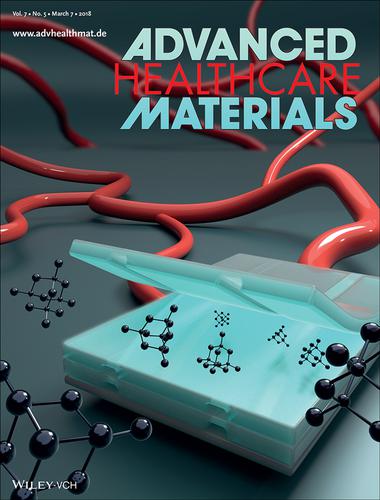当前位置:
X-MOL 学术
›
Adv. Healthcare Mater.
›
论文详情
Our official English website, www.x-mol.net, welcomes your
feedback! (Note: you will need to create a separate account there.)
Tissue Engineering: Silicon Carbide Nanoparticles as an Effective Bioadhesive to Bond Collagen Containing Composite Gel Layers for Tissue Engineering Applications (Adv. Healthcare Mater. 5/2018)
Advanced Healthcare Materials ( IF 10.0 ) Pub Date : 2018-03-07 , DOI: 10.1002/adhm.201870023 Rana Attalla 1 , Celine S. N. Ling 1 , Ponnambalam Ravi Selvaganapathy 1, 2
Advanced Healthcare Materials ( IF 10.0 ) Pub Date : 2018-03-07 , DOI: 10.1002/adhm.201870023 Rana Attalla 1 , Celine S. N. Ling 1 , Ponnambalam Ravi Selvaganapathy 1, 2
Affiliation

|
In article number 1701385, Ponnambalam Ravi Selvaganapathy and co‐workers use a lamination‐based planar processing strategy enabled by nanoparticle adhesives to address one of the prominent technical challenges found in the tissue engineering field – the incorporation of perfusable hollow networks for nutrient and waste transport within artificial 3D tissue constructs. Without these vascular‐like networks, the cells embedded within the constructs would quickly become necrotic. Silicon Carbide, used as a nanoadhesive, has been shown to be very effective in adhering microstructured layers of biologically important extracellular matrices containing collagen to form perfusable 3D netoworks suitable for growing cells.

中文翻译:

组织工程:碳化硅纳米颗粒作为一种有效的生物粘合剂,可以粘结包含胶原蛋白的复合凝胶层,用于组织工程应用(Adv。Healthcare Mater。5/2018)
在编号1701385中,Ponnambalam Ravi Selvaganapathy及其同事使用了基于层压的平面处理策略,该策略由纳米粒子粘合剂实现,以解决组织工程领域发现的一项重大技术挑战–将可灌注的空心网络纳入营养和废物运输在人工3D组织构造中。如果没有这些类似血管的网络,构建体中嵌入的细胞将迅速坏死。碳化硅用作纳米粘合剂,已被证明在粘附含有胶原的生物学上重要的细胞外基质的微结构层形成非常适合用于生长细胞的可灌注3D网络中非常有效。

更新日期:2018-03-07

中文翻译:

组织工程:碳化硅纳米颗粒作为一种有效的生物粘合剂,可以粘结包含胶原蛋白的复合凝胶层,用于组织工程应用(Adv。Healthcare Mater。5/2018)
在编号1701385中,Ponnambalam Ravi Selvaganapathy及其同事使用了基于层压的平面处理策略,该策略由纳米粒子粘合剂实现,以解决组织工程领域发现的一项重大技术挑战–将可灌注的空心网络纳入营养和废物运输在人工3D组织构造中。如果没有这些类似血管的网络,构建体中嵌入的细胞将迅速坏死。碳化硅用作纳米粘合剂,已被证明在粘附含有胶原的生物学上重要的细胞外基质的微结构层形成非常适合用于生长细胞的可灌注3D网络中非常有效。












































 京公网安备 11010802027423号
京公网安备 11010802027423号